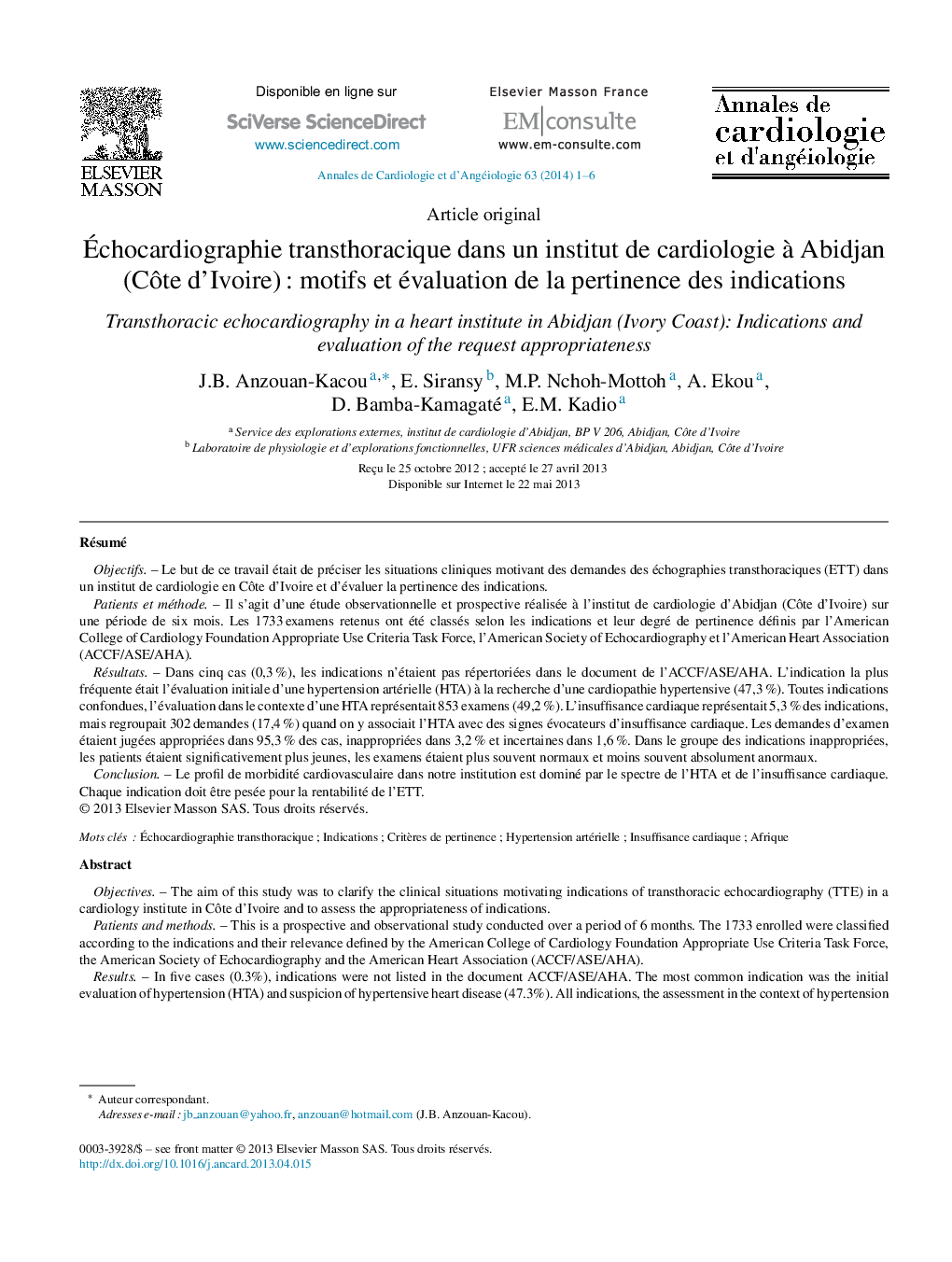| Article ID | Journal | Published Year | Pages | File Type |
|---|---|---|---|---|
| 2868748 | Annales de Cardiologie et d'Angéiologie | 2014 | 6 Pages |
RésuméObjectifsLe but de ce travail était de préciser les situations cliniques motivant des demandes des échographies transthoraciques (ETT) dans un institut de cardiologie en Côte d’Ivoire et d’évaluer la pertinence des indications.Patients et méthodeIl s’agit d’une étude observationnelle et prospective réalisée à l’institut de cardiologie d’Abidjan (Côte d’Ivoire) sur une période de six mois. Les 1733 examens retenus ont été classés selon les indications et leur degré de pertinence définis par l’American College of Cardiology Foundation Appropriate Use Criteria Task Force, l’American Society of Echocardiography et l’American Heart Association (ACCF/ASE/AHA).RésultatsDans cinq cas (0,3 %), les indications n’étaient pas répertoriées dans le document de l’ACCF/ASE/AHA. L’indication la plus fréquente était l’évaluation initiale d’une hypertension artérielle (HTA) à la recherche d’une cardiopathie hypertensive (47,3 %). Toutes indications confondues, l’évaluation dans le contexte d’une HTA représentait 853 examens (49,2 %). L’insuffisance cardiaque représentait 5,3 % des indications, mais regroupait 302 demandes (17,4 %) quand on y associait l’HTA avec des signes évocateurs d’insuffisance cardiaque. Les demandes d’examen étaient jugées appropriées dans 95,3 % des cas, inappropriées dans 3,2 % et incertaines dans 1,6 %. Dans le groupe des indications inappropriées, les patients étaient significativement plus jeunes, les examens étaient plus souvent normaux et moins souvent absolument anormaux.ConclusionLe profil de morbidité cardiovasculaire dans notre institution est dominé par le spectre de l’HTA et de l’insuffisance cardiaque. Chaque indication doit être pesée pour la rentabilité de l’ETT.
ObjectivesThe aim of this study was to clarify the clinical situations motivating indications of transthoracic echocardiography (TTE) in a cardiology institute in Côte d’Ivoire and to assess the appropriateness of indications.Patients and methodsThis is a prospective and observational study conducted over a period of 6 months. The 1733 enrolled were classified according to the indications and their relevance defined by the American College of Cardiology Foundation Appropriate Use Criteria Task Force, the American Society of Echocardiography and the American Heart Association (ACCF/ASE/AHA).ResultsIn five cases (0.3%), indications were not listed in the document ACCF/ASE/AHA. The most common indication was the initial evaluation of hypertension (HTA) and suspicion of hypertensive heart disease (47.3%). All indications, the assessment in the context of hypertension represented 853 examinations (49.2%). Heart failure accounted for 5.3% of indications, but consisted of 302 applications (17.4%) when was associated hypertension with signs suggestive of heart failure. Requests were considered as appropriate in 95.3%, inappropriate in 3.2% and uncertain in 1.6%. In the group of inappropriate indications patients were significantly younger, and were examinations more often normal and less often absolutely abnormal.ConclusionThe profile of cardiovascular morbidity in our institution is dominated by the spectrum of hypertension and heart failure. Each indication must be balanced for the profitability of the ETT.
